

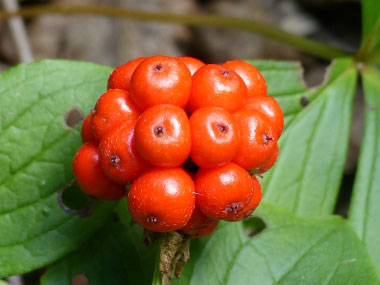
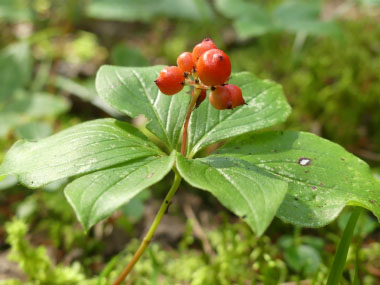
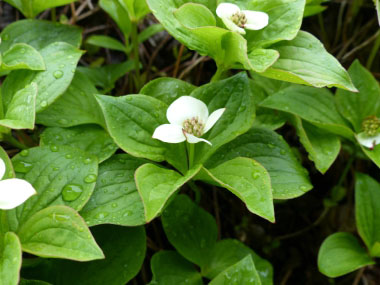
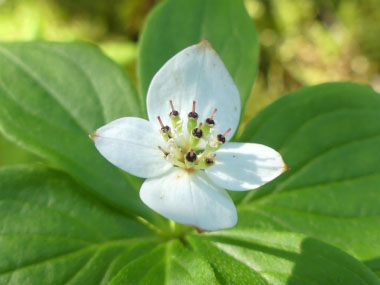
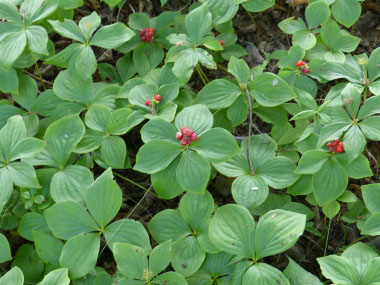
To support our efforts please browse our store (books with health benefits, etc.).
Cornus canadensis is a species of flowering plant in the Cornaceae (dogwood) family. The bunchberry is in forests across Canada, most parts of the US and in the far north, and it provides food for wildlife and for people. Interestingly, the flower petals spring back the stamens which thrust outward and a hinged strap connecting the stamen to the anther quickly accelerates the pollen to 24,000 m/s2 or about 800 times the force experienced by astronauts during launch. This serves to propel the pollen into the air an astonishing 10 times the height of the flower. This Cornus species is one of many being investigated for natural chemotherapeutic compounds with potential for application in cancer treatment.
Distinguishing Features
The bunchberry, or bunchberry dogwood, is a low, erect perennial plant, that can be found individually but are more like to grow in colonies. It's cluster of red berries situated above distinct shaped leaves with parallel veins make this easy to identify.
Flowers
A dense cluster of small greenish-white to purplish flowers form above the leaf whorl. They consist of 4 large (1 - 2 cm long), showy, tinged, white to purple petal-like bracts that appear in early summer. When the fruit develops, it is red, fleshy, and grows in a terminal cluster; ripening by midsummer.
 Fields
of Nutrition has medicinal benefits and vitamin/mineral content of Bunchberry.
Fields
of Nutrition has medicinal benefits and vitamin/mineral content of Bunchberry.
Leaves
Leaves are evergreen and grow opposite. They develop 4 to 6 leaves in a whorl at the top of the stem, often with 1 or 2 pairs of smaller, leaf-like scales on the stem below.Leaves are elliptic or egg-shaped, 2 - 6 cm long with the margins tapering to a point at both ends. Leaf veins are parallel.
Height
This plant grows anywhere from 10 to 20 cm tall, from a spreading rhizome; stems are 5 to 15 cm tall and they have a somewhat woody base.
Habitat
These plants grow (approx) from the mid US to the far north, including Greenland and the Canadian Arctic islands. Bunchberry dogwood occurs in coniferous, deciduous, and mixed forests. It is particularly widespread in the understory of spruce and fir forests. It prefers moist, organically rich, acidic soils in part shade including sun-dappled conditions in close to full shade.
Edible Parts
The mature fruit (and seeds) of this plant can be eaten raw or cooked. It has a very mild flavour not making it too desireable for snacking on. They have a high concentration of flavonoids and vitamin C so they are worth foraging. The berries are mealy so they are not exactly a sought-after berry for culinary uses. However, they preserve well and can be added into jams, puddings, other baked treats and teas. They contain high levels of pectin making them a great addition with low pectin fruits when making jams.
Other Name
Creeping Dogwood.
Winter Survival Food Handbook

PDF Plant Magazines
Types of Wild Food
Geographic Zones Seasons
Disclaimer
EdibleWildFood.com is informational in nature. While we strive to be 100% accurate, it is solely up to the reader to ensure proper plant identification. Some wild plants are poisonous or can have serious adverse health effects.
We are not health professionals, medical doctors, nor are we nutritionists. It is up to the reader to verify nutritional information and health benefits with qualified professionals for all edible plants listed in this web site. Please click here for more information.
Why Edible Wild Food?
- Food costs are rising
- Free, wild food is readily abundant
- Wild food adds nutrition to your diet
- Wild food can help treat various medical conditions





